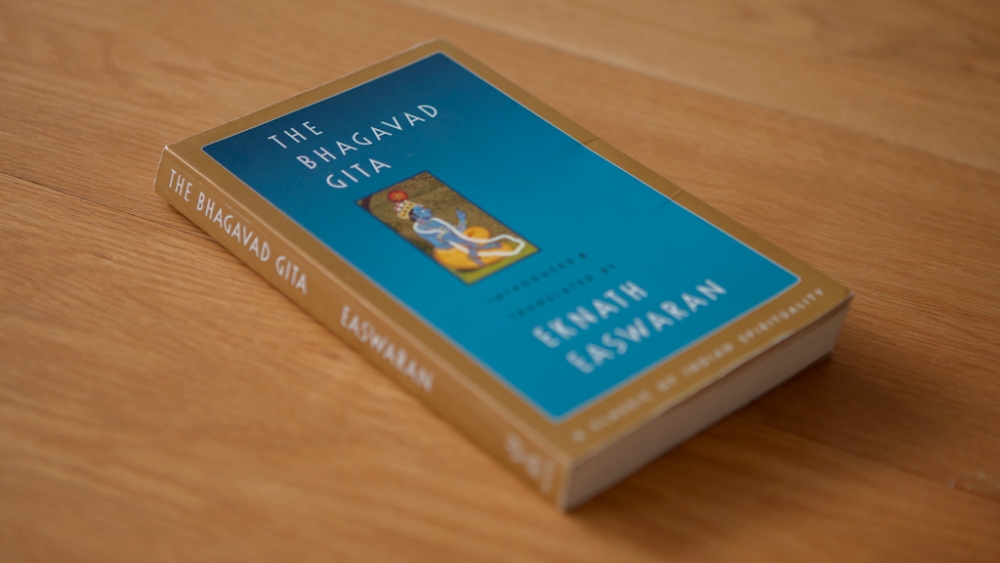Each day upon waking we have a choice. Which will we decide to listen to today: our true and higher self, or our ego? The days we decide to listen to the true Self are usually the ones where we feel that we’re living our purpose and honouring our true nature. The days we decide to listen to the ego are usually the ones where we face the most difficulty, and life can seem a little like a battlefield.
The Bhagavad Gita – a guidebook to life
The Bhagavad Gita is one of India’s ancient texts and is derived from the epic poem, The Mahabharata. This still stands as the longest poem ever written, with over 100,000 shlokas or over 200,000 verses. Though only a part of The Mahabharata, the Bhagavad Gita is perhaps one of the most important and highly revered yogic texts ever to have been written.
Texts like The Upanishads and the Dhammapada are also part of this poem. But it’s the Bhagavad Gita that’s often cited as holding the key to personal transformation:
The Bhagavad Gita is a map and a guidebook. It gives us a systematic overview of the territory [of life], shows various approaches to the summit with their benefits and pitfalls, offers recommendations, tells us what to pack and what to leave behind. More than either of the others (the Upanishads and the Dhammapada), it gives the sense of a personal guide. It asks and answers the questions that you or I might ask. Questions not about philosophy or mysticism, but about how to live life effectively in a world of challenge and change.
~ Eknath Easwaran – The Upanishads Introduction
The story – relevance and symbolism
The whole story of the Bhagavad Gita takes place on the battlefield of Kurukshetra, upon which two sides of a family – the Pandavas and the Kauravas – are preparing for battle. The text itself focuses on a conversation between two characters: Krishna and Arjuna.
Like many other writings of this period such as the Upanishads and the Dhammapada, the Bhagavad Gita or ‘Song of The Lord’ seems timeless. Its story is relevant whether we lived a thousand years ago, or we’re living in the modern age. We explore what happens when Arjuna has to make difficult, life-changing decisions – specifically the decision as to whether he should battle against his own family members in a war of ‘good’ versus ‘evil’ – and the importance of living a life of truth and purpose.
The most interesting and often misunderstood aspect of the Bhagavad Gita is that it’s entirely representational and highly symbolic. There is no actual battlefield or fight to be won. The entire text represents the battle that goes on in our minds. It is about understanding how we can overcome difficulty, self-doubt, and ultimately live a life of truth and purpose.
The Bhagavad Gita is entirely representational and highly symbolic. There is no real battlefield or fight to be won; the entire text is a representation of the battle that goes on in our minds.
This text speaks to anyone who ever feels as though their mind is a battlefield. It is as relevant to today’s practitioners as it was to ancient yogis.
The characters
In order to get the most from the text, it’s important to understand what each character represents:
- Arjuna: us in our human form, with all our doubts, worries and habits…. He represents you and I as we stand on the battlefield of life facing all the different parts of ourselves that prevent us from realising our true nature.
- Krishna: the ‘higher Self’ or ‘divine’.
- The Pandavas: the great virtues within us.
- The Kauravas: the opposing forces within us.
- The Chariot: our physical body.
- The Horses: our 5 senses that need to be guided by the Self so we can realise our true nature.
Less drama, more Dharma
The pages of the Bhagavad Gita delve into the aspect of ‘Dharma’. Dharma translates as ‘that which upholds’ or ‘life purpose’. Henry David Theroux, John Keats, Walter Hagan and even Beethoven are known to have found comfort and guidance in the pages of the Bhagavad Gita. Gandhi was another prominent figure who considered the text to be a crucial component in uncovering his life’s purpose.
Famous writers like Henry David Theroux, John Keats and Walter Hagan and even composer Beethoven are known to have found comfort and guidance in the pages of the Bhagavad Gita. Gandhi was another prominent figure who considered the text to be a crucial component in uncovering his life’s purpose.
The thing is though, the ‘Gita doesn’t tell us how to live our own life’s purpose’, as Simon Hass points out in his own book on dharma – The Dharma Code:
‘Young graduates are encouraged to “find their passion” and then “pursue their dreams”. This advice, often dished out at graduation ceremonies, is misguided. Most successful young people don’t look inside and then plan a life. They don’t take an inward journey and come out having discovered a developed self, ready to meet the challenges of the world. No, living allows them to find themselves. By confronting challenges in life, by finding a problem that summons their energies, they discover what they are capable of and what is important to them. In other words, our potential or purpose manifests not through a process of cognition, but through our vital engagement with the world’.
~ Simon Hass – The Dharma Code
Life’s ‘purpose’
Whatever we might consider our ‘life purpose’ to be, there’s one purpose we all have: to live life fully. To explore all there is to explore within and without ourselves. As Siddhartha Gautama said – “to discover your world and with all your heart – give yourself to it”.
Whatever we might consider our ‘life purpose’ to be, there’s one purpose we all have: to live life fully, to explore all there is to explore within and without ourselves.
Life may sometimes seem like a battlefield, but it’s also referred to as a ‘drama’ in many of the texts. When we look at it this way we can ask ourselves, “am I playing my part fully?” Are we giving ourselves to our life and our world and living purposefully?
The Bhagavad Gita encourages us to live life with purity, strength, discipline, honesty, kindness and integrity. In this way we can find our purpose and live it fully. Just as Krishna urges Arjuna to cast aside all doubts and trust in his highest Self, we too can use the wisdom of the Bhagavad Gita to meet our own difficulties and decisions with fearlessness and honesty, and learn to live life authentically and fully.
Learn yoga philosophy online
Interested in learning more about the Bhagavad Gita and the concepts of yoga philosophy? Take a look at Anat Geiger’s online course on our Academy.
Learn more in class…
Myth and Asana: Be a Yogi with Irina Verwer
In this class with Irina Verwer, you’ll hear what happened to the main characters of the Bhagavad Gita and how you can translate Krishna’s advice and use it in your own life. You’ll move through a short meditation, some heart and hip openers and an energizing sequence.
Related reads:
- Why should we study yoga philosophy?
- The 8 Limbs of Yoga explained
- How do we connect with who we truly are?


